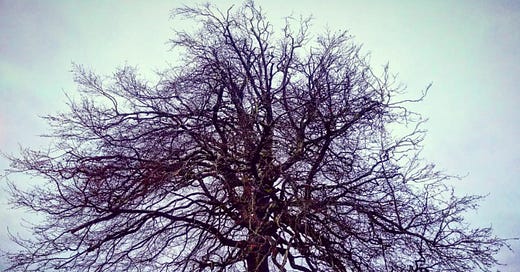Insurance company agrees to further assessments of iconic Kinsale beech tree
The ancient tree in the grounds of Kinsale Outdoor Education Centre was set for felling last week, but under protest from locals, the insurance company has agreed to further assessments.
The fate of an ancient beech tree in the grounds of Kinsale’s Outdoor Education Centre (OEC) still hangs in the balance this week as it awaits further tests to determine whether or not it should be considered “dangerous.”
Insurance company IPB, who had told the OEC that the continuation of their insurance depended on having the tree felled, have now agreed that a ground radar assessment should be carried out before a decision is made.
The iconic beech on Compass Hill, which is believed to be 250 years old, has been the subject of much debate over the past two weeks. After a petition to postpone the felling of the beech tree received over a hundred signatories and OEC director Jon Hynes met with concerned locals on February 6, the OEC announced that the felling had been postponed.
At the date of writing the petition has 281 signatories, and politicians including local Green Party councillor Marc Ó Riain and Fianna Fáil TD Christopher O’Sullivan, have weighed in in favour of preserving the tree.
Christopher O’Sullivan told TG4 last week that his uncle and grandfather went to the school which used to be beside the beech tree, and that they still remember it today. He described it as a historic tree that should be protected and preserved.
OEC director Jon Hynes did not have comment for Tripe + Drisheen. However, he stressed in a press release last week that the Outdoor Education Centre did not wish to fell the tree and was operating under instruction from their insurance company, IPB.
The OEC had “experienced significant rockfall events from the cliff,” Mr Hynes wrote, saying that in 2019, after visits by two arborists, they chose a programme of crown reduction over total removal, “in the hope of preserving the tree.”
However, the centre’s insurers, IPB, told the OEC last Autumn that they would not continue to provide insurance to the centre unless the tree were felled, “due to the precarious location of the tree on top of the cliff.”
Tree in perfect health
Tripe + Drisheen spoke with a local tree surgeon who was in contact with the arborists whose surveys were the basis for these judgements, and they all agree that the tree is in perfect health.
The only reason the tree was assessed by the arborists and Cork County Council area engineers as being in the “high to severe category of risk” is due to its positioning near a steep rock face.
The tree surgeon argued that simply looking at the tree from ground level is not enough to understand the risk associated with it. He called for a ground radar assessment, which “goes through tarmac and stone so you can see exactly where the roots are” and also a tomography which utilises a belt that “sends soundwaves through the tree so you can see if there are any cavities inside it.”
This tree surgeon and others who have been campaigning for the tree to remain believe that a crown reduction programme is enough to reduce the “sail effect” of the tree’s branches during stormy conditions.
Insurance company IPB have now confirmed to campaigners that a ground radar assessment will be carried out on the tree.
“All measures are being explored to avoid removing the tree if possible and we agree that a ground radar assessment should be carried out,” the insurers said in an email. “The situation will be reviewed once the findings of the assessment have been received.”
Weak laws
The fate of the beech tree remains to be seen and locals can only hope that IPB will allow the tree to remain, as there is limited legal recourse available in these instances.
Since the local Government (Planning & Development) Act 1963, planning authorities can grant Tree Preservation Orders (TPOs) “where it is considered desirable to preserve trees on amenity grounds,” not for ecological reasons.
While Cork County Council will not provide a list of TPOs in Cork, they point to the national tree register which lists 97 Heritage tree sites in Cork county. According to the Cork City Council Development Plan 2022, there were 12 TPOs in Cork city, twice as many as in Dublin.
It is unlikely that a protection order could be used to save the beech tree on Compass Hill though, as TPOs do not apply to trees “which have become dangerous,” which is what the insurers are now trying to establish in Kinsale.
Since the Forestry Act of 2014, cutting down a tree in Ireland also does not require a felling license if the tree is “in an urban area” or “within 30 metres of a building, but excluding any building built after the trees were planted” amongst other exemptions, the first of which clearly applies to the beech tree.
In contrast the UK and Germany, amongst other countries, have no such exemptions.
It seems what happens next depends entirely on whether IPB insurance deems the tree dangerous or not.






Lowest tree cover in Europe.Leave it alone.